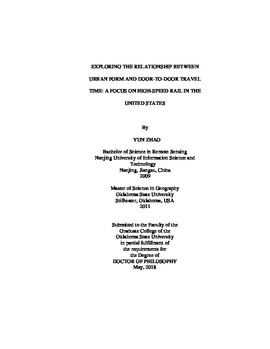| dc.contributor.advisor | Yu, Hongbo | |
| dc.contributor.author | Zhao, Yun | |
| dc.date.accessioned | 2019-03-25T21:13:41Z | |
| dc.date.available | 2019-03-25T21:13:41Z | |
| dc.date.issued | 2018-05 | |
| dc.identifier.uri | https://hdl.handle.net/11244/317725 | |
| dc.description.abstract | High-speed rail (HSR) is gaining increasing attention in the United States due to its rapid development and success in Europe and Asia in recent decades. Traveling at a high speed, HSR is expected to increase the accessibilities of the cities it connects and is considered a competitive alternative to existing travel modes for short to medium distance intercity travel. While current HSR accessibility studies tend to focus primarily on the intercity portion of HSR travel, an HSR intercity trip is composed of both access/egress time to the traveling facilities at the intracity level and on-board travel time at the intercity level. To provide a more accurate measurement of total journey time, this research proposes and defines a door-to-door travel time framework that integrates trip segments at both the inter- and intra-city levels simultaneously. Based on this framework, three independent yet connected research components are conducted to better identify the accessibility benefits of HSR under the sprawling urban form of U.S. cities. First, this research explores how the compactness of cities can affect overall access time to traveling facility of intercity trips via different travel modes. Second, by accounting for access/egress time differences at different locations within a city, the door-to-door framework is introduced to examining the variations of the accessibility advantage of HSR over its competitors (i.e., air and auto) at the sub-city level. A case study on the proposed Dallas-Houston HSR corridor is carried out to demonstrate the feasibility of the approach and reveal where HSR holds accessibility advantage over existing intercity travel modes between the two cities. Last, a trend analysis on the urban form development of Dallas and Houston is carried out to explore the evolving urban form of the two cities from 2002 to 2014. Emphases are given on their implications on the proposed HSR project in the region. Results of this research can help policy makers and transportation planners more accurately evaluate the accessibility advantages of HSR and understand how HSR will compete with existing intercity travel modes at a finer spatial scale in the U.S. context. | |
| dc.format | application/pdf | |
| dc.language | en_US | |
| dc.rights | Copyright is held by the author who has granted the Oklahoma State University Library the non-exclusive right to share this material in its institutional repository. Contact Digital Library Services at lib-dls@okstate.edu or 405-744-9161 for the permission policy on the use, reproduction or distribution of this material. | |
| dc.title | Exploring the relationship between urban form and door-to-door travel time: A focus on high-speed rail in the United States | |
| dc.contributor.committeeMember | Finchum, G. Allen | |
| dc.contributor.committeeMember | Comer, Jonathan C. | |
| dc.contributor.committeeMember | Liu, Tieming | |
| osu.filename | Zhao_okstate_0664D_15652.pdf | |
| osu.accesstype | Open Access | |
| dc.type.genre | Dissertation | |
| dc.type.material | Text | |
| thesis.degree.discipline | Geography | |
| thesis.degree.grantor | Oklahoma State University | |
